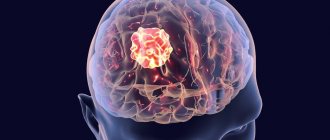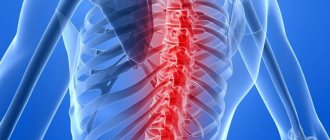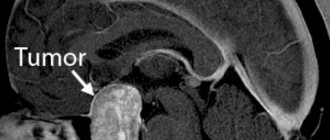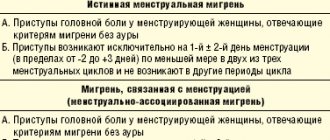Pain Treatment Center
Alekseeva
Oksana Alexandrovna
23 years of experience
Doctor, highest qualification category, member of the European Association of Neurologists, Russian Interregional Society for the Study of Pain (ROIB), Association of Interdisciplinary Medicine. Has experience working in hospital and outpatient services. He has seven published works on neurology.
Make an appointment
In ensuring the normal functioning of the human body, one of the key positions is occupied by the autonomic nervous system (ANS) - a complex of nervous structures responsible for maintaining a constant internal environment (homeostasis). The efforts of the ANS regulate the functioning of the circulatory and lymphatic systems, internal organs, and endocrine glands. The ANS itself is part of the nervous system (NS), but has an important feature - autonomy, that is, a person cannot control it with his own will.
Various disorders in the functioning of the ANS are called vegetative-vascular dystonia (VSD). This term does not mean a separate disease itself, but a syndrome - a condition caused by diseases of certain organs and systems (mental or somatic pathologies, hormonal imbalances).
Main symptoms and signs
The manifestations of VSD are diverse; the general list includes over several dozen items, but patients experience only a few of them (usually from 5 to 20) in different combinations. An important point: with VSD, there is a combination of several symptoms that appear simultaneously, but in the complete absence of organic disorders. A separate manifestation of any of these signs is not a reason for diagnosing vegetative-vascular dystonia, since it usually indicates a specific pathology.
Doctors distinguish several forms of VSD, classifying them on the basis of identifying relatively typical sets of symptoms that resemble the course of certain pathologies of organs or systems.
Respiratory form of VSD
Respiratory vegetative-vascular dystonia is the most common. The patient complains of the inability to take a deep breath, is afraid of suffocating, gasps for air, feels soreness, tightness in the throat, heaviness or pain in the chest, and coughs frequently.
Tachycardial form
Complaints of rapid heartbeat (tachycardia), irregular heart rhythm, sensation of vascular pulsation and heat in the temples and neck. It should not be confused with a similar picture with arrhythmia, paroxysmal tachycardia.
Cardiological form
In the area of the heart, pain of a different nature is noted (long-term aching or sharp, sharp), without a clear localization. During an attack of cardiac vegetative-vascular dystonia, the patient is anxious and breathes heavily. The pain lasts longer than with cardiovascular diseases (angina pectoris, myocardial infarction), does not depend on physical activity and is not relieved by appropriate medications (validol, nitroglycerin and others).
Hypotonic form
Characterized by dizziness, darkening of the eyes, sudden perspiration on the forehead, sweating, weakness, cold palms. Blood pressure drops briefly to 90/60 or below.
Hypertensive form
During an attack, tachycardia and heart pain are observed against the background of a short-term increase in blood pressure. The main difference from real hypertension: the pressure does not exceed 150/90.
Asthenic form
Performance decreases, complaints of fatigue, weakness, inability to concentrate, and sometimes body temperature rises slightly. Tremor (shaking in the hands) is possible, especially with the slightest physical exertion or a stressful situation. Irritability for no apparent reason or due to insignificant reasons, tearfulness.
Visceral form
Manifested by symptoms from the gastrointestinal tract (functioning disorder, nausea, diarrhea, vomiting, irritable bowel syndrome).
Mixed form
It combines certain signs characteristic of all the above forms of VSD, in arbitrary combinations.
Sometimes patients experience acute manifestations of symptoms, so-called attacks of dystonia or vegetative crises. An attack of VSD is characterized by sudden, spontaneous and rapid development, regardless of the circumstances. It can happen both during physical activity or a stressful situation, and at rest or sleep; alone or in a crowded place. Patients are afraid of suffocation, fear of death from respiratory or cardiac arrest, some feel feverish, others feel cold.
Separately, it is worth mentioning pre-syncope and fainting. They can have different origins; based on trigger mechanisms, they are distinguished:
- psycho-emotional - as a result of experiences, fear, reaction to the sight of blood;
- orthostatic - due to a sudden change in position, usually when abruptly getting up from a chair or bed;
- hypotonic – due to a sharp decrease in blood pressure.
Loss of consciousness is usually short-lived, lasting 1-3 minutes, the patient quickly comes to his senses. A history of fainting may indicate more severe pathologies, such as adrenal or cardiovascular insufficiency, nephropathy, or diabetes mellitus.
With such an impressive range of complaints, patients often do not experience any pathological changes in the structure or functioning of organs and systems. They often experience fear of developing a serious pathology, attributing to themselves some kind of disease based on similar signs. So, some fear paralysis due to mild numbness of the limbs or a heart attack due to chest pain.
Do you have symptoms of vegetative-vascular dystonia (VSD)?
Only a doctor can accurately diagnose the disease. Don't delay your consultation - call
Rule 1: do not ignore the advice of the obstetrician-gynecologist who is managing your pregnancy
In the third trimester of gestation, trips to the antenatal clinic become frequent. After 36 weeks of pregnancy, a woman visits an obstetrician-gynecologist every week. What can the doctor advise you during the consultation? First of all, monitor your weight gain, count the amount of fluid you drink and excrete per day.
The amount of fluid you drink is all drinks, soups, and half the volume from fruits and dairy products. The amount of fluid excreted is the volume of urine (diuresis). If these numbers are the same, then everything is great. If the volume of fluid consumed exceeds daily diuresis, this may indicate hidden edema that forms in the intercellular spaces of tissues and organs.
Hidden edema can be a consequence of kidney disease and heart problems. But the most common reason for their appearance is gestosis, which is a complication of pregnancy.
If left untreated, gestosis leads to serious consequences:
- pulmonary edema;
- placental abruption;
- delayed fetal development;
- premature birth.
Preeclampsia is accompanied not only by hidden edema, but also by swelling of the arms and legs, high blood pressure, and proteinuria - the appearance of protein in the urine.
Diagnostics
To begin with, the doctor, during a conversation with the patient, collects a detailed anamnesis - finds out the complaints, their nature, frequency of occurrence, the presence of a hereditary factor (are there people in the family who suffer from confirmed VSD).
Then a general examination is carried out, attention is paid to the patient’s behavior and his emotional background.
Due to the presence of symptoms similar to those of various other diseases (arrhythmia, hypertension, pathologies of the thyroid gland, gastritis, etc.), each patient with suspected VSD must undergo a detailed therapeutic examination in a clinical setting. To confirm the diagnosis of VSD, it is necessary to absolutely exclude diseases with similar symptoms. For this purpose, laboratory tests are prescribed:
- general blood analysis;
- general urine analysis;
- liver and kidney function indicators;
- analysis of thyroid hormone levels;
- clarifying tests at the discretion of the doctor.
Next, a referral is given for instrumental examinations, of which the most frequently used are:
- electrocardiography (ECG);
- echocardiography;
- 24-hour Holter blood pressure monitoring;
- fibrogastroduodenoscopy;
- Ultrasound of the abdominal organs, kidneys, neck vessels, thyroid gland;
- chest x-ray;
- spirometry;
- bicycle ergometry.
Sometimes the doctor requires additional diagnostic methods, such as computed tomography (CT), magnetic resonance imaging (MRI), electroencephalography, colonoscopy and others. Various functional tests are also carried out (psycho-emotional, orthostatic, physical exercise, pharmacological).
Analogs
There are several types of analogues of this drug. Some of these are structural analogues: Angiovit and Multitabs B-complex. They are good drug substitutes and are actively prescribed in complex therapy. There are different drugs in the price category.
Neuromultivitis or Milgamma?
There are a number of analogues of Neuromultivit, which are quite ways to replace the drug in certain clinical cases. For example, if we consider the drug Neuromultivit in comparison with Malgamma, we can identify several advantages of each vitamin complex. Thus, both drugs are included in the group of neurotropic vitamins. The active substances included in the drugs are similar. However, Milgamma additionally contains lidocaine hydrochloride. This means that as part of complex therapy, both drugs will function equally, but Milgamma will also provide a more pronounced analgesic effect for pain syndromes.
Neuromultivitis or Combilipen?
Neuromultivit and Combilipen belong to the group of neutrotropic vitamins and have the same composition and contraindications. However, Combilipen also contains the substance lidocaine, which is a strong analgesic. Vitamin complexes have different manufacturers: Combilipen is produced by a domestic pharmaceutical company. In addition, the drug has a wider list of side effects. The price category of drugs is also different. The doctor prescribes this or that complex to the patient strictly according to individual indications.
Neuromultivitis or Neurobion?
Neuromultivit and Neurobion have a similar composition and work according to the same scheme. However, they also have slight differences in composition: Neurobion contains 0.04 mg more cyanocobalamin than Neuromultivit. This allows Neurobion to be prescribed to patients who have a history of diseases of the circulatory system. The specialist prescribes a particular drug based on indicators that are revealed during the collection of a detailed medical history: concomitant diseases, age, individual tolerance of each component, the patient’s well-being for a given period.
Neuromultivit or Pentovit?
Both drugs have a similar composition of vitamins, however, in addition to vitamins B1, B6 and B12, Pentovit also contains nicotinamide and folic acid in small doses. The drugs prevent hypovitaminosis and replenish the supply of vitamins in our body. Pentovit is prescribed in much larger dosages than Neuromultivit, since the latter contains vitamin components with a higher concentration. Neuromultivit has a foreign manufacturer, so its price is much higher than Pentovit.
Neuromultivitis or Berocca?
The drugs Neuromultivit and Berocca are complexes of B vitamins and have a similar composition. However, the drug Berocca contains trace elements such as calcium, magnesium, as well as nicotinamide, pantothenic acid and biotin. There are more indications for taking Berocca. Neuromultivitis is prescribed for more serious diseases, since its action is based solely on the vitamin B complex. Specialists prescribe both drugs, but each patient is selected a medicine strictly individually.
Causes of occurrence and development
The etiology of VSD, as well as its symptoms, is extremely diverse. Among the main reasons, doctors name:
- pathological changes that occurred during pregnancy or childbirth (intrauterine hypoxia, infectious process, birth injuries, etc.);
- changes in hormonal levels (during puberty or during hormonal therapy);
- hereditary tendency (presence of autonomic disorders in close relatives);
- traumatic brain injuries of any severity;
- traumatic stressful situation, frequent psycho-emotional stress;
- high mental stress;
- excessive, or conversely, insufficient physical activity;
- toxic effects of certain substances;
- unbalanced, irregular nutrition;
- long-term course of chronic diseases (diabetes mellitus, hypertension, coronary heart disease, bronchial asthma, hypo- and hyperthyroidism, gastric ulcer, etc.);
- chronic lack of sleep, sleep disorder;
- sudden changes in weather conditions or prolonged stay in a place with severe climatic conditions;
- the presence of foci of infectious agents (chronic sinusitis, rhinitis, otitis, tonsillitis, etc.);
- bad habits (smoking, alcoholism, drug addiction).
There are certain risk groups, people from whom are more likely than others to develop VSD: people who are underweight or overweight, have low resistance to stress, and occupy responsible positions; girls during puberty, women during pregnancy and menopause.
Treatment
Therapeutic measures consist of a set of effective methods, each of which is selected individually. Since most of the occurrences of VSD occur due to stress, it makes sense to pay attention to ways to combat them:
- normalization of sleep;
- rejection of bad habits;
- building an adequate work and rest regime, if necessary, the issue of changing jobs is considered;
- nutritious nutrition in compliance with the meal schedule;
- performing special sets of physical exercises, therapeutic exercises, yoga;
- work with a psychologist (individual or group classes, psychological trainings, consultations);
- physiotherapeutic procedures (massage, electrophoresis, contrast and therapeutic showers, etc.);
- Spa treatment.
All of the above methods are quite effective; when used, not only the disappearance of VSD symptoms is noted, but also an overall positive effect on the body as a whole.
Drug interactions
It is not recommended to take the drug simultaneously with antiparkinsonian drugs. One of them is levodopa. This reduces the effectiveness and performance of the antiparkinsonian drug and reduces the effectiveness of its use to zero. In case of unintentional violation of the instructions, you should postpone taking the vitamin complex.
The drug Neuromultivit should not be prescribed with other vitamin complexes containing B vitamins, as this can lead to an overdose.
Preparations that contain the substance ethanol can also reduce the efficiency of absorption of the vitamin complex. The benefit of taking drugs of this nature at a time is minimal.
Drug therapy for VSD
Prescription of medications is resorted to in case of ineffectiveness of non-drug measures. Treatment of VSD involves the use of medications strictly as prescribed by the doctor. Only a specialist determines the necessary drugs, their dosage and frequency of administration in each specific case. Among the main groups of medications are:
- sedatives of plant origin (normalize sleep, have a mild and effective effect);
- antidepressants – reduce anxiety, relieve headaches of varying intensity and duration;
- tonic and restorative drugs (improve tone, increase resistance to stress, physical and mental stress);
- metabolic agents – improve and normalize metabolic processes in the body, in particular in the brain and nervous system;
- tranquilizers - prescribed with caution, as they have clear indications and many side effects;
- microelements and vitamins;
- drugs aimed at eliminating various specific symptoms and their causes (hypotensive, antiarrhythmic, prokinetics, antispasmodics, etc.).
The patient must understand that VSD does not belong to the category of severe pathologies. With proper treatment and strict adherence to medical recommendations, recovery is guaranteed. The right attitude towards recovery plays an important role, when a person is not afraid of the manifestations of dystonia, but strives to overcome them. This is especially true for attacks of anxiety, restlessness, and various phobias - as soon as the groundlessness of such fears is realized, they gradually disappear forever.
Therefore, it is very important not to be afraid to talk about the problem. Sometimes patients are embarrassed by this and are in a vicious circle when they cannot cope with the problem on their own, but do not dare to visit a doctor. And it’s completely in vain, because already during a conversation with a specialist it turns out that it is much easier to cope with the situation together, moreover, the prognosis is favorable.
pharmachologic effect
B vitamins play an important role in the human body: in addition to combating hypovitaminosis and vitamin deficiency, their function is to influence the regulation of metabolism in the central nervous system. The active ingredients of the drug also allow you to achieve an analgesic effect, which is effective in the fight against neuralgia and pain. After reading the manufacturer's instructions, you can find out that the vitamin complex copes with metabolic disorders.
Many vitamins are not able to be formed spontaneously in the body, so a person needs to replenish their supply in more accessible ways, taking a complex of vitamins in the form of tablets or suspensions.
In case of disturbances in the functioning of the nervous system, doctors also prescribe a course of B complex vitamins. This is due to the fact that the components included in the drug provide direct stimulation to trigger the natural restoration of areas of nervous tissue. Thanks to active neurotropic substances, which, in turn, play the role of coenzymes in the processes of the central and peripheral nervous system, the active course of intermediate metabolism is triggered.
In addition, the drug is non-toxic, which means it will not cause harm to human health. The course is prescribed to both children and adults according to the prescribed dosage.
Pharmacodynamics
The components included in the drug have the leading properties for stimulating pharmacological action. The drug contains substances such as thiamine, pyridoxine and cyanocobalamin, vitamins B1, B6, B12, respectively. A lack of these components in the human body can lead to neurological disorders, in particular in the peripheral nervous system.
B vitamins have anti-inflammatory degenerative properties, which have a beneficial effect on the functioning of the nervous system and the musculoskeletal system. In addition to these functions, Neuromultivit actively regulates blood flow, and its components participate in the most important biochemical reactions of the body and are an indispensable catalyst.
Neuromultivitis plays an important role in the regulation of protein, carbohydrate and fat metabolism. Vitamin B1 is also a source for conducting nerve impulses at synapses. A complex of vitamins is used in the treatment of neuralgia, radiculitis, peripheral paresis and paralysis. Thiamine content in large quantities is observed in striated muscles, in particular in the myocardium.
Pharmacokinetics
Thiamine after intramuscular administration is absorbed from the gastrointestinal tract. The distribution in the body is uneven, but the vitamin is found in red blood cells in large quantities, equal to 75 percent. It is excreted by the kidneys immediately after 20 minutes. The final metabolites are pyramine, thiaminecarboxylic acid and others. Thiamine is considered a vitamin that is stored in the body in the lowest concentrations.
Pyridoxine. After the vitamin is administered intramuscularly, it enters the bloodstream and is evenly distributed throughout the body. A larger amount of the vitamin binds to blood plasma proteins. Pyridoxine is evenly distributed throughout the body. It is excreted in urine after 2–2.5 hours.
Cyanocobalamin. When administered parenterally, the cyanocobalamin component forms a bond with the transport protein. Absorbed by the liver and bone marrow. Able to penetrate the placental barrier.
Doctors treating VSD
In addition to the attending physician, a neurologist, endocrinologist, otolaryngologist, ophthalmologist, and instrumental diagnostic specialists take part in the process of diagnosing VSD. Depending on the symptoms, you may need to consult a specialist doctor - cardiologist, gastroenterologist, pulmonologist, urologist and other related specialties.
At the clinic of JSC “Medicine”, a comprehensive approach allows us to accurately establish the mechanisms of the occurrence and development of VSD, triggers, and timely identify or exclude concomitant pathologies. Doctors of the highest category with many years of experience, doctors of medical sciences, practice here. This is the key to successful treatment, but much depends on the patient himself: how timely he sought qualified medical help, how carefully he followed the doctor’s instructions for diagnosis and treatment.
Indications for treatment
The main indication is a clinically confirmed diagnosis of vegetative-vascular dystonia. Since VSD is a syndrome, the indications for its therapy correspond to disorders of various etiologies: vascular, psychological, neurological, cardiological and many others.
If your professional responsibilities involve high mental and emotional stress, stressful situations, overwork, or if you have a hereditary predisposition to VSD, sign up for a consultation with a specialist. Timely prevention will help avoid worsening problems, because the disease is easier to prevent than to treat.
Contraindications
Contraindications for the treatment of VSD are determined by the methods used. If we talk about drug therapy, then almost every drug has contraindications for use. The same can be said about physiotherapeutic procedures. That is why the course and tactics of treatment are determined by a highly qualified doctor who is able to take into account all factors.
There is one contraindication that is simultaneously applicable in all cases - self-treatment. In the case of VSD, this is especially true, since such patients are often excessively suspicious and tend to attribute severe pathologies to themselves. In an attempt to treat a non-existent disease, they can not only significantly aggravate their situation, but also cause irreparable harm to the body.
special instructions
Under no circumstances should the drug be administered in the form of a solution for intramuscular injection into the vascular bed intravenously. This may entail the risk of adverse reactions of the body: deterioration of the condition as a whole or allergic reactions in the form of anaphylactic shock. If you violate the instructions, you should contact a specialist.
The absorption time of thiamine increases when the vitamin complex is consumed simultaneously with alcohol or strong tea.
Neuromultivit is a drug containing a component of vitamin B6. For persons with a history of peptic ulcers or intestinal disorders, the dosage is reduced or the drug is replaced. If the renal system and liver are not functioning satisfactorily, you should also be careful in using this drug.
The course of treatment is 4 weeks. When using a complex of vitamins for a longer period, dysfunctions of the nervous system may occur: the appearance of symptoms of neuralgia.
For persons whose profession involves driving vehicles and working with complex mechanisms, there are no special instructions or prohibitions. There are strictly individual cases when the situation requires specialist consultation.
Neuromultivit is also used in complex therapy in the treatment of heart failure and vascular disease.
Cost of initial appointment, diagnostic examinations and treatment
As for the initial appointment, its cost in most cases is low; in fact, it is a consultation procedure. But one should not neglect its importance - an experienced doctor is able to recognize characteristic symptoms and notice even small but important manifestations of abnormalities.
The price of diagnostic procedures and laboratory tests may vary significantly in different clinical cases. For one patient, general tests and several examinations will be enough; for another, diagnosis may take longer and require additional studies and tests. This is due to both the complex nature of VSD and the individual characteristics of each patient’s body.
A similar picture is typical for treatment. Its cost is determined by many factors; sometimes the therapeutic process has to be adjusted. To roughly navigate the prices for diagnosis and treatment of VSD in Moscow, you can familiarize yourself with the corresponding table of costs for the most common diagnostic procedures.
Advantages of treating VSD at the clinic of JSC "Medicine"
Vegetative-vascular dystonia is a multifactorial disorder in the body; its successful treatment requires an integrated approach and coordinated work of doctors of many specialties. Among the undeniable advantages of JSC “Medicine” (clinic of academician Roitberg), it is worth mentioning 3 key points:
- High professionalism of doctors - the staff consists of more than 300 experienced practicing doctors and diagnosticians of 67 medical specialties. Leading corresponding members of the Russian Academy of Sciences, academicians, professors, doctors and candidates of medical sciences advise here. The clinic was the first in Russia to receive accreditation according to the international standards for assessing the quality of medical care JCI. Joint Commission International, considered the highest level of accreditation worldwide.
- Ultra-modern technical base - equipped with the latest generation diagnostic and treatment equipment from the world's leading manufacturers. This allows you to create your own scientific and clinical developments in almost all medical areas. For many years, the clinic of JSC "Medicine" has served as a clinical base for the Department of Therapy and Family Medicine of the Russian National Research Medical University named after N.I. Pirogov (RNIMU) and is among the innovatively active healthcare institutions in Moscow.
- High-quality medical care - the effectiveness and safety of treatment is guaranteed by the principle of Academician N.A. Semashko, which states: “One patient - one doctor.” The attending physician is assigned to each patient and works closely with colleagues from related medical specialties. A developed diagnostic base and medical care technology built according to international standards make it possible to make a diagnosis at an unprecedented speed. In just 1 day from the moment of the initial examination and diagnostic measures, you can receive detailed results of laboratory tests, detailed diagnostic reports and doctor’s recommendations.
It is important to know: VSD is not a critically severe disorder, but can provoke one in the absence of proper medical care. In case of early access to a doctor, treatment time is significantly reduced and financial costs are reduced. Don’t delay your visit, make an appointment at a time convenient for you, and we will help you regain your health!
Why you should take vitamin D
There are several reasons for this:
- It is produced in the body only after contact with direct sunlight. Therefore, a chronic lack of this component is the result of rare exposure to the sun.
- If it is not possible to obtain the required dose of ultraviolet radiation, this is fraught with health problems. They can only be avoided by regularly taking nutritional supplements that contain vitamin D.
- There is very little of it in the daily diet. This vitamin is found in fatty sea fish and cod liver. But even with the consumption of these products, its deficiency is not fully compensated.
Back in 2007, scientists from Oregon conducted diagnostics among the local population. There were a total of 976 participants of retirement age. According to research results, only 25% of women and 49% of men have enough vitamin D in their bodies. According to statistics, about 70% of people do not have enough vitamin D, so it is necessary to convey this information to the population and regularly take vitamin D supplements.
The normal amount in the body is considered to be 50 ng/ml. On average, in a healthy person, the concentration of this vitamin should be from 40 to 80 ng/ml. At the same time, the risk of deterioration in health is observed already when its level drops to 10-24 ng/ml.








